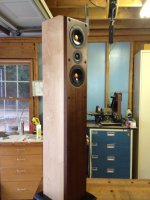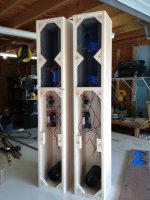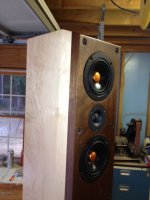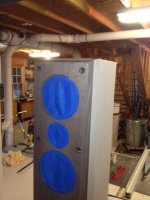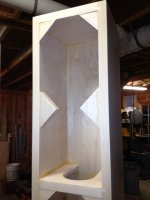One assembled and one to go waiting for damaged cap, then on to the "complete" completion!!!
The feet I am not sure of yet, may just use a base, don't know as wifey doesn't care for the ones attached.
The bass, really nice, more than I expected. More later.
The feet I am not sure of yet, may just use a base, don't know as wifey doesn't care for the ones attached.
The bass, really nice, more than I expected. More later.
Attachments
Robert,
Yes, the bass is very fine and I'm more impressed as I listen to my speakers. With your slot port you have a 3 dB down point in the mid 30 Hzs range. My protoype units have very nice bass impact which is a surprise for such a small enclosure.
Let us know how they sound once you have both units finished and dialed in. They should satisfy your need for bass.
Jim
Yes, the bass is very fine and I'm more impressed as I listen to my speakers. With your slot port you have a 3 dB down point in the mid 30 Hzs range. My protoype units have very nice bass impact which is a surprise for such a small enclosure.
Let us know how they sound once you have both units finished and dialed in. They should satisfy your need for bass.
Jim
Thanks, Jim, I certainly will. The bass is certainly amazing and I am looking forward to hearing 2 instead of one.
I have come up with a clever idea, (I think, anyway), of integrating an interesting base with the feet. This is the prototype....
Thanks,
Robert
I have come up with a clever idea, (I think, anyway), of integrating an interesting base with the feet. This is the prototype....
Thanks,
Robert
Attachments
Well, one more waxing and I will be finished, finally. With the "Attack of the Inner Ear Bug" I have been demobilized for the completion. But now I am very close.
Very, very happy with the results in the listening end of these towers, first I love the shape, they fit anywhere. They make an elegantly formal statement with their height. Which, for me is ear perfect with the tweeter. Jim you did a great job with the bass extension and Jeff's crossover design make these keepers.
Thanks, for you hard work again!
Very, very happy with the results in the listening end of these towers, first I love the shape, they fit anywhere. They make an elegantly formal statement with their height. Which, for me is ear perfect with the tweeter. Jim you did a great job with the bass extension and Jeff's crossover design make these keepers.
Thanks, for you hard work again!
Attachments
Thanks, Jim!
This is probably one of the easiest finishes to do, since everything doesn't have to be perfect. The best is not having to use a primer, except for the inside, which I do. One just has to seal the ends of the MDF with glue and water and the Rust-Oleum flat paint does the rest.
I have sent Jim W. pics of them, but he has been following the build. Interesting, he is the one who read about the Tritons and told me I should build them....Thanks, Jim!!!
The next build will be of different drivers and a different style, but by the same designer. Instead of red undertones, I think it will be a medium brown pine stain color.
The bass is just wonderful, couldn't be better and the size, as I mentioned, is great as well.
Robert
This is probably one of the easiest finishes to do, since everything doesn't have to be perfect. The best is not having to use a primer, except for the inside, which I do. One just has to seal the ends of the MDF with glue and water and the Rust-Oleum flat paint does the rest.
I have sent Jim W. pics of them, but he has been following the build. Interesting, he is the one who read about the Tritons and told me I should build them....Thanks, Jim!!!
The next build will be of different drivers and a different style, but by the same designer. Instead of red undertones, I think it will be a medium brown pine stain color.
The bass is just wonderful, couldn't be better and the size, as I mentioned, is great as well.
Robert
Mr. BF,
Updates on the new build or updates on the TL?
The TL is singing right along, using the pair now for theater/2 channel. Did some Spotify listening to the new Tanghetto Release "Hybrid Tango", or least new to Spotify and really enjoyed the separation and detail the Tritons give. Prefer Source direct on the Marantz, but adding the sub in stereo mode adds even more to the bass.
At one point the new build might have been another pair, since I like them so much, but just wanted something different this time around.
Very happy with the decision to change from MTM to TL though.
Updates on the new build or updates on the TL?
The TL is singing right along, using the pair now for theater/2 channel. Did some Spotify listening to the new Tanghetto Release "Hybrid Tango", or least new to Spotify and really enjoyed the separation and detail the Tritons give. Prefer Source direct on the Marantz, but adding the sub in stereo mode adds even more to the bass.
At one point the new build might have been another pair, since I like them so much, but just wanted something different this time around.
Very happy with the decision to change from MTM to TL though.
Greetings,
I'm a newbie on this forum, but have been following this thread for awhile. I put together boxes for these Triton towers last week, and have just received the drivers and crossovers yesterday from Meniscus. Quality of the CSS components looks really good, and I can't wait to have them in place.
One question for anyone out there: is the 3" port just pvc pipe? I haven't done the port yet, but was assuming this. With the way I constructed the box (with a removable front baffle), I need to go with a tube.
I'll post some pics soon, but I do appreciate the work that went into the design, by Jeff, Jim, and others.
Thanks,
Bobbob
I'm a newbie on this forum, but have been following this thread for awhile. I put together boxes for these Triton towers last week, and have just received the drivers and crossovers yesterday from Meniscus. Quality of the CSS components looks really good, and I can't wait to have them in place.
One question for anyone out there: is the 3" port just pvc pipe? I haven't done the port yet, but was assuming this. With the way I constructed the box (with a removable front baffle), I need to go with a tube.
I'll post some pics soon, but I do appreciate the work that went into the design, by Jeff, Jim, and others.
Thanks,
Bobbob
Last edited:
bobbob,
I prefer the look of the slot port which was detailed a few pages ago in this thread. But a slot tube is built-in during the construction.
PVC tube or cardboard mailing tube can also be used as a port tube and you can cut it to fit your desired length.
For my prototype boxes I used a round plastic port tube. A plastic tube with a flange such as the Parts Express #260-404 will suffice. That tube is 4.5 inches long so you may wish to lengthen it a bit to tune the box to a lower frequency. One possibility is to insert a cardboard mailing tube inside the 4.5" tube. Now a 3" inside diameter mailing tube will not fit inside the plastic 3" diameter tube but it will fit if you cut the mailing tube lengthwise. Thus you can fashion a tube to a variable length by moving the mailing tube inside the plastic port tube.
Jim
I prefer the look of the slot port which was detailed a few pages ago in this thread. But a slot tube is built-in during the construction.
PVC tube or cardboard mailing tube can also be used as a port tube and you can cut it to fit your desired length.
For my prototype boxes I used a round plastic port tube. A plastic tube with a flange such as the Parts Express #260-404 will suffice. That tube is 4.5 inches long so you may wish to lengthen it a bit to tune the box to a lower frequency. One possibility is to insert a cardboard mailing tube inside the 4.5" tube. Now a 3" inside diameter mailing tube will not fit inside the plastic 3" diameter tube but it will fit if you cut the mailing tube lengthwise. Thus you can fashion a tube to a variable length by moving the mailing tube inside the plastic port tube.
Jim
Last edited:
I entered the Triton MTM MLTL in the speaker design competition at the Midwest Audio Fest in Dayton, Ohio last weekend. The MWAF contest, which is sponsored by Parts Express, is one of the most competitive DIY speaker events in the country. You can learn more about the contest at:
Midwest Audiofest 2013 - Speaker Design Competition
A visual walk around the room at the MWAF is shown at:
MWAF2013 - YouTube
The Tritons show up at the 3:06 mark in the walk around video.
The Tritons were placed in the greater than $200 driver cost classification. The entries are judged in five categories which assess their craftsmanship, originality/design, tonal balance, clarity, and soundstage/imaging. The judges this year were Jerry McNutt, Odu Wohlgemuth, and Don Keele (he of recent CBT array fame). You can read brief bios on the judges at the link.
Six entries were in the over $200 classification. The speakers are judged by listening to three musical selections. This year the music included a choral group, a male vocalist, and an orchestral segment.
One of Bogdan's creations (see the overview of Bogdan's speakers at:
6moons audio reviews: Bogdan Audio Creations Catalina
nipped my Triton MTM MLTLs for first place. Bogdan’s speakers (at the 1:13 mark in the walk around video) feature a SB Acoustics 7” woofer and a Fountek Neo X 3.0 ribbon in hand crafted enclosures.
Even though the Tritons were second in their class, the scores between the top two were close so the Tritons can hold their own with other high quality speakers.
Midwest Audiofest 2013 - Speaker Design Competition
A visual walk around the room at the MWAF is shown at:
MWAF2013 - YouTube
The Tritons show up at the 3:06 mark in the walk around video.
The Tritons were placed in the greater than $200 driver cost classification. The entries are judged in five categories which assess their craftsmanship, originality/design, tonal balance, clarity, and soundstage/imaging. The judges this year were Jerry McNutt, Odu Wohlgemuth, and Don Keele (he of recent CBT array fame). You can read brief bios on the judges at the link.
Six entries were in the over $200 classification. The speakers are judged by listening to three musical selections. This year the music included a choral group, a male vocalist, and an orchestral segment.
One of Bogdan's creations (see the overview of Bogdan's speakers at:
6moons audio reviews: Bogdan Audio Creations Catalina
nipped my Triton MTM MLTLs for first place. Bogdan’s speakers (at the 1:13 mark in the walk around video) feature a SB Acoustics 7” woofer and a Fountek Neo X 3.0 ribbon in hand crafted enclosures.
Even though the Tritons were second in their class, the scores between the top two were close so the Tritons can hold their own with other high quality speakers.
Triton MLTL tower implemented...
Well... I hesitated to post till I was done, but we're up and running and things seem to sound really nice. I had to tune down my sub quit a bit. Where does to low freq sound come from these things! And we are just into the break-in phase.
And we are just into the break-in phase.
The basic boxes are hard maple, all rabbeted and glued only, and the fronts are Peruvian walnut. I beveled the fronts by about a half inch on each side and top to make for some serious tearout when flush routing the baffles.
The front baffles were supposed to be removable, but because of my mistakes they are are now permanently attached.
I have no measurement equip to tell how they compare, but I am really satisfied.
Thank you to Mr. Griffin and Mr. Bagby for the design work behind these things.
bobbob (aka greybeard, aka Scot)
Well... I hesitated to post till I was done, but we're up and running and things seem to sound really nice. I had to tune down my sub quit a bit. Where does to low freq sound come from these things!
The basic boxes are hard maple, all rabbeted and glued only, and the fronts are Peruvian walnut. I beveled the fronts by about a half inch on each side and top to make for some serious tearout when flush routing the baffles.
The front baffles were supposed to be removable, but because of my mistakes they are are now permanently attached.
I have no measurement equip to tell how they compare, but I am really satisfied.
Thank you to Mr. Griffin and Mr. Bagby for the design work behind these things.
bobbob (aka greybeard, aka Scot)
Attachments
bobbob,
Thanks for the photos and taking a chance on this design. Your choice of woods is keen--they really look beautiful.
Yes, the bass is there in spades and will improve as the drivers break-in. These speakers are overachievers and impressive for their size. A sub helps if you want dynamics below 30 Hz say for movies and organ music but the frequency range is such that most music genres will sound great with just these speakers. I'm really impressed on how these speakers image with a soundstage wider than the speakers. No small sweet spot with these guys.
Having the front glued on isn't the end of the world. You can remove one of the woofers if you need to change the stuffing a bit to suit your room. A bright room with a lot of hard surfaces may sound better if the box is more heavily stuffed. Lighter stuffing for a room with a lot of absorbing surfaces such as carpeting, drapes, overstuffed furniture and such.
Let us hear again how they sound after a few more weeks of break-in.
Jim
Thanks for the photos and taking a chance on this design. Your choice of woods is keen--they really look beautiful.
Yes, the bass is there in spades and will improve as the drivers break-in. These speakers are overachievers and impressive for their size. A sub helps if you want dynamics below 30 Hz say for movies and organ music but the frequency range is such that most music genres will sound great with just these speakers. I'm really impressed on how these speakers image with a soundstage wider than the speakers. No small sweet spot with these guys.
Having the front glued on isn't the end of the world. You can remove one of the woofers if you need to change the stuffing a bit to suit your room. A bright room with a lot of hard surfaces may sound better if the box is more heavily stuffed. Lighter stuffing for a room with a lot of absorbing surfaces such as carpeting, drapes, overstuffed furniture and such.
Let us hear again how they sound after a few more weeks of break-in.
Jim
Last edited:
Greebster, Jim
Thanks. I am currently no speaker design guru, and am dependent on the the true desiggn professionals.
I varied a bit from the design, with a box of 7/8 hard maple and front baffle of 3/4 walnut. Even with a somewhat narrowed baffel it stilll sounds good.
Thanks,
Scot (aka bobbob)
Thanks. I am currently no speaker design guru, and am dependent on the the true desiggn professionals.
I varied a bit from the design, with a box of 7/8 hard maple and front baffle of 3/4 walnut. Even with a somewhat narrowed baffel it stilll sounds good.
Thanks,
Scot (aka bobbob)
Just reading about these I am completely impressed, great drivers, crossover, cabinet design, everything! One question for Jim, you mentioned different tuning possibilities with different port lengths. Why not have a downfiring port with the speaker up on one or two inch risers over a bottom plate. This could allow people to try different port lengths and select what the like best in the room they are using, and even switch out to other ports if they move the speakers to other locations. What do you think?
Just reading about these I am completely impressed, great drivers, crossover, cabinet design, everything! One question for Jim, you mentioned different tuning possibilities with different port lengths. Why not have a downfiring port with the speaker up on one or two inch risers over a bottom plate. This could allow people to try different port lengths and select what the like best in the room they are using, and even switch out to other ports if they move the speakers to other locations. What do you think?
In a MLTL the port does not tune the system but rather the length does. The port is tuned to the Fs of the driver to maximally dampen it. You can detune it with the port, but then that's a BR and not a TL.
Actually I'm beginning to wonder if this can be called a TL. If the drivers load the line from the exact same distance top to bottom yes and if the lines were isolated from one another yes. But if staggered laterally the line is incorrectly loaded and acts unlike a TL and more like a BR with TL characteristics. It's one of those fuzzy grey areas
Last edited:
Actually in an ML-TL both the 1/4-wavelength resonant frequency of the line's length and the port's dimensions combine to create the overall tuning frequency. The longer the line, the more it contributes to the tuning and the less from the port. Conversely the shorter the line the less it contributes and more comes from the port. In a design like this where the cabinet's internal height is the line's length, the 1/4-wave resonant frequency will fall in the range of 80-90 Hz, so an appreciable amount of the system tuning comes from the port. It's incorrect to assume, then, that the port is tuned to the driver's Fs. You could call it "just" a tall, vented box but there's another advantage that isn't usually taken into account with typical vented box modeling software, optimizing the port's location for the best combination of tuning frequency and location relative to the midwoofer(s), resulting in the smoothest overall response. The line's design center is the midpoint between the two midwoofers which is the center of the tweeter. You can use the stuffing density and location for tweaking to taste but in my experience I've never changed either after building exactly what I modeled (YMMV).
Paul
Paul
In a MLTL the port does not tune the system but rather the length does. The port is tuned to the Fs of the driver to maximally dampen it. You can detune it with the port, but then that's a BR and not a TL.
Actually I'm beginning to wonder if this can be called a TL. If the drivers load the line from the exact same distance top to bottom yes and if the lines were isolated from one another yes. But if staggered laterally the line is incorrectly loaded and acts unlike a TL and more like a BR with TL characteristics. It's one of those fuzzy grey areas
Last edited:
Thanks Paul for your insight.
My comments on stuffing and port tuning are based upon both my knowledge of how Martin's MLTL simulation can be iterated and my experiences with MLTLs that I have built and tested. In regard to the stuffing issue, I'm like Paul that once I complete the simulations and have built the prototypes to match, I normally don't change the stuffing.
But a few years ago I learned a lesson about stuffing and how can it vary in-room performance of a MLTL. I built a MLTL design and stuffed it a little on the heavy side (I didn't take time to measure the stuffing weight vs. the calculated density in the sim). The MLTL sounded just fine in my listening room but my room is very 'live' with wood floors and no draperies and minimal soft surfaces that absorb in-room sound. Later I carried the MLTL to a new location that had more normal household furnishings and I was surprised that the bass region sounded a bit muted and overly damped. When I returned home I removed about one third of the stuffing material from the MLTL. In my listening room the speaker then sounded more alive than previous observations. Later in other venues this MLTL had much better balanced sound than I originally experienced. My take away was that stuffing does matter and can be varied to best match the environment in which the speaker is placed.
On port tuning again the simulations yield results that are generally spot on so there is no great worry once you have the speaker assembled. During simulations, I vary both the port tube diameter and length to achieve my desired goals. In most cases the length of the port can be increased to lower the F3 (3 dB down point) a few Hz but at the expense of more variation of the low end bass frequency response. My advice is to moderate the tendency to push the F3 as low as you can vs. settling for a smoother, flatter response.
Per Octavia suggestion a few posts ago, an after build experiment on port length (before final assembly of the port in the box) is to use a cardboard mailing tube to checkout adjustments that could be made to the port tube length. You can cut various lengths and listen (or even near field measure the port response) to assess whether you like or can accept the various iterations of the bass response. Of course if you use a slot port terminus, then you may have to figure out how to experiment with the enclosure if you wish to play games.
Finally, Paul Kittinger's write-up on MLTL for the work he did for Philharmonic Audio is worth a read. You will find it at:
Bass Response
Are we having fun yet?
Jim
My comments on stuffing and port tuning are based upon both my knowledge of how Martin's MLTL simulation can be iterated and my experiences with MLTLs that I have built and tested. In regard to the stuffing issue, I'm like Paul that once I complete the simulations and have built the prototypes to match, I normally don't change the stuffing.
But a few years ago I learned a lesson about stuffing and how can it vary in-room performance of a MLTL. I built a MLTL design and stuffed it a little on the heavy side (I didn't take time to measure the stuffing weight vs. the calculated density in the sim). The MLTL sounded just fine in my listening room but my room is very 'live' with wood floors and no draperies and minimal soft surfaces that absorb in-room sound. Later I carried the MLTL to a new location that had more normal household furnishings and I was surprised that the bass region sounded a bit muted and overly damped. When I returned home I removed about one third of the stuffing material from the MLTL. In my listening room the speaker then sounded more alive than previous observations. Later in other venues this MLTL had much better balanced sound than I originally experienced. My take away was that stuffing does matter and can be varied to best match the environment in which the speaker is placed.
On port tuning again the simulations yield results that are generally spot on so there is no great worry once you have the speaker assembled. During simulations, I vary both the port tube diameter and length to achieve my desired goals. In most cases the length of the port can be increased to lower the F3 (3 dB down point) a few Hz but at the expense of more variation of the low end bass frequency response. My advice is to moderate the tendency to push the F3 as low as you can vs. settling for a smoother, flatter response.
Per Octavia suggestion a few posts ago, an after build experiment on port length (before final assembly of the port in the box) is to use a cardboard mailing tube to checkout adjustments that could be made to the port tube length. You can cut various lengths and listen (or even near field measure the port response) to assess whether you like or can accept the various iterations of the bass response. Of course if you use a slot port terminus, then you may have to figure out how to experiment with the enclosure if you wish to play games.
Finally, Paul Kittinger's write-up on MLTL for the work he did for Philharmonic Audio is worth a read. You will find it at:
Bass Response
Are we having fun yet?
Jim
Last edited:
- Status
- This old topic is closed. If you want to reopen this topic, contact a moderator using the "Report Post" button.
- Home
- Loudspeakers
- Multi-Way
- The Triton MTM Grows Legs--A MLTL Design
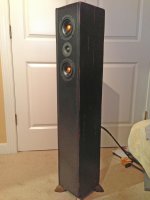
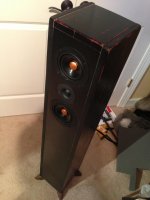
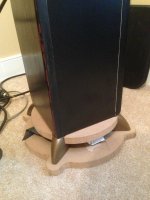
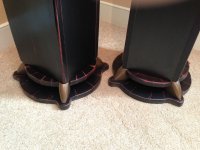
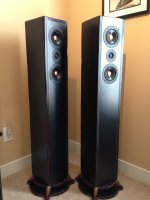
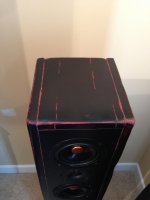
![IMG_0863[1].jpg](/community/data/attachments/308/308267-26d2c8e3c5ac9cc5f897a17094eae47a.jpg)
